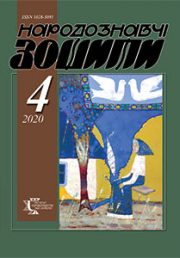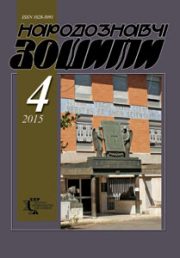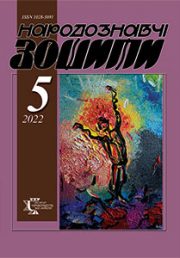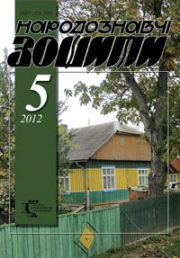The Ethnology Notebooks. 2022. № 6 (168), 1377—1385
UDK 378.4:7]:[37.096:7.047](438.1):763(477.83—25)”185″
DOI https://doi.org/10.15407/nz2022.06.1377
KUPCHYNSKA Larysa
- ORCID ID: https: //orcid.org/0000-0001-6461-4819
- Candidate of Art History, Associate Professor,
- Director of the Research Institute for Art Library Resources;
- Vasyl Stefanyk National Scientific Library of Ukraine in Lviv,
- 2, Stefanyka Street, 79000, Lviv, Ukraine,
- Contacts: e-mail: oklarysa@gmail.com
Abstract. The analysis of the literature proves the selectivity of the study of the issue of the formation of the landscape genre in the Ukrainian art of the 19th century in general. Scholars have not addressed the issue of the influence of the Academy of Fine Arts of Vienna thereon. This additionally argues the relevance of the research topic. This publication arms at revealing the place and role of the landscape school of the Academy of Fine Arts of Vienna in the history of Ukrainian art, its importance in the formation of the distinctive character of Lviv lithographs depicting the views of various cities and localities of Eastern Galicia in the first half of the 19th century.
The article deals with the landscape genre of the western region of Ukraine in the first half of the 19th century, the development of which was significantly influenced by the Academy of Fine Arts of Vienna. The formation of the school of landscape painting of the Vienna Academy in the context of the development of Ukrainian art is analyzed. The main tasks of the leading educational institution in Europe since its opening in 1692 are outlined. The article examines the methods of teaching students used by teachers in the 18th and early 19th centuries. Particular attention is paid to the Engraving Academy, where the founders of the national landscape Franz Edmund Weirotter and Johann Christian Brand worked. Their merit was the training of creative youth in the open air. The article reveals the main ways of spreading the traditions of the landscape school of the Academy of Fine Arts of Vienna, taking into account historical events and changes in the social and cultural life of Eastern Galicia. The activities of the main lithographic workshops of Lviv in the first half of the 19th century are outlined. The main emphasis is on the publications of Josef and Peter Piller. The lithographs of Anton Lange and Carl Auer are analyzed. The adaptation of the achievements of the landscape school of the Academy of Fine Arts of Vienna on local soil is presented on the example of the creative heritage of famous artists, the author’s approach of graphics to the solution of intended tasks in the context of aesthetic issues. The artistic thinking of that time is shown.
The methodological basis of the work is the principles of objectivity and historicism. The method of art analysis was used to reveal the compositional and visual-content solutions of the works.
Keywords: landscape genre, Academy of Fine Arts of Vienna, lithography, Pillers’ Workshop, Anton Lange, Carl Auer.
Received 14.11.2022
REFERENCES
- Krypiakevych, I. (without a year). Stavropygian lithography in 1847—1854. [Lviv] [in Ukrainian].
- Opalek, M. (1958). Lviv lithograph 1822—1860. Wroclaw; Krakow: Ossolinski National Institute [in Polish].
- Korol, S. (2004). Romantic Albums of Lithographs Sheets: From «The Collections of the Most Pictoresque and Interesting Sites of Galicia» (1823) to «The Surroundings of Galicia» (1847—48). The Ethnology Notebooks, 3/4, 413—427 [in Ukrainian].
- Korol, S. (2006). Tradition of veduti in the Lvov topographical landscapes of the first half XIX century. Bulletin of Kharkiv State Academy of Design and Arts (Issue 6, pp. 96—106) [in Ukrainian].
- Gregor, J. (1944). The Academy of Fine Arts in Vienna: an outline of its history on the occasion of its 250th anniversary; 1692—1942. Vienna: Wilgelm Frick’s publishing company [in German].
- Lutzow, C. v. (1877). History of the Imperial Kings Academy of Fine Arts. Vienna: Publishing company of Carl Gerold’s Son [in German].
- Koller, M. (1993). The Strudel brothers: Court artistes and founders of the Vienna Art Academy. Innsbruck; Vienna: Tyrolia’s publishing company [in German].
- Zmolnig, B. (2008). Jakob Mattias Schmutzer (1733—1811): The landscape drawings from the copperplate engraving cabinet of the Academy of Fine Arts in Vienna: Diploma thesis… academic degree Magistra in Philosophy, University of Vienna. Vienna [in German].
- Weinkopf, A. (1875). Description of the Imperial Kings Academy of Fine Arts in Vienna. 1783 and 1790. Vienna: Self-published by Imperial Kings Academy of Fine Arts [in German].
- Hofstatter, S. (1973). Johann Christian Brand (1722—1795): Dissertation… of the doctoral degree, University of Vienna. Vienna [in German].
- Kupchynska, L. (2018). Artists of the Viennese art school in theateral life of Lviv at the end of the 18th century and in the first half of the 19th century. The Ethnology Notebooks, 5, 1255—1267 [in Ukrainian].
- Derhachova, H. (1994). A forgotten L’viv landscape by Anthony Lange. Notes of the Shevchenko Scientific Society (Vol. ССХХVII, pp. 387—392) [in Ukrainian].
- Korol, S. (2004). Anton Lange: between the Classical landscape and model studies. Notes of the Shevchenko’s Scientific Society (Vol. CCXLVIII, pp. 152—165) [in Ukrainian].
- (1823). Gone out too… Sundries, 69, 552 [in Polish].
- Vvedenskyi, O. (2012). Lviv and Halychyna in Karl Auer’s lithographs. Lviv: Center of Europe [in Ukrainian].







